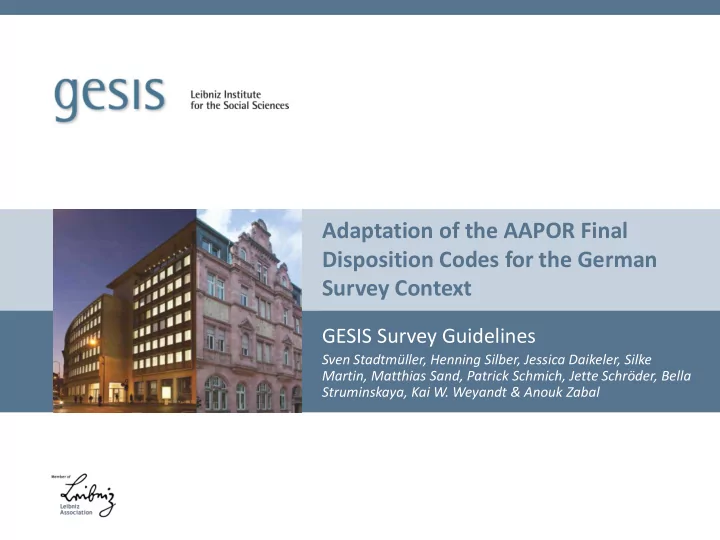

Adaptation of the AAPOR Final Disposition Codes for the German Survey Context GESIS Survey Guidelines Sven Stadtmüller, Henning Silber, Jessica Daikeler, Silke Martin, Matthias Sand, Patrick Schmich, Jette Schröder, Bella Struminskaya, Kai W. Weyandt & Anouk Zabal
These slides are based on the GESIS Survey Guideline paper about the adaptation of the AAPOR final disposition codes for the German survey context: Stadtmüller, S., Silber, H., Daikeler, J., Martin, S., Sand, M., Schmich, P., Schröder, J., Struminskaya, B., Weyandt, K. W., & Zabal, A. (2019). Adaptation of the AAPOR Final Disposition Codes for the German Survey Context. Mannheim, GESIS – Leibniz-Institute for the Social Sciences (GESIS – Survey Guidelines). doi: 10.15465/gesis-sg_en_026 Please cite the slides as: Stadtmüller, S., Silber, H., Daikeler, J., Martin, S., Sand, M., Schmich, P., Schröder, J., Struminskaya, B., Weyandt, K. W., & Zabal, A. (2020). Slide Set: Adaptation of the AAPOR Final Disposition Codes for the German Survey Context. GESIS Survey Guidelines. Mannheim, Germany: GESIS – Leibniz Institute for the Social Sciences. A complete list of all references used on these slides can be found in the above mentioned Survey Guideline paper. This work is licensed under a Creative Commons Attribution – NonCommercial 4.0 International License (CC BY-NC). 2
AAPOR final disposition codes ▪ Response rates are one of the most widely considered survey quality indicators ▪ Reported response rates and their calculation should be transparent Which persons were excluded from its calculation and why? Which persons were regarded as not eligible? ▪ AAPOR final disposition codes suggest a classification for the reporting of response rates ▪ However, this classification is often disregarded by researchers… 3
Practices in reporting response rates von Hermanni, H., & Lemcke, J. (2017). A Review of Reporting Standards in Academic Journals – A Research Note. Survey Methods: Insights from the Field. Retrieved from https://surveyinsights.org/?p=8625 4
AAPOR final disposition codes ▪ In Germany, the proportion of survey programs that report response rates according to the AAPOR classification is even lower The AAPOR final disposition codes were developed for the US survey landscape So far there is no standardized approach to adapt these codes for the German context ▪ In the GESIS Survey Guideline, we propose adaptations for telephone, face-to-face, internet, and mail surveys 5
AAPOR final disposition codes ▪ AAPOR final disposition codes are grouped into four main categories 1. Persons that were eligible and interviewed 2. Persons that were eligible but not interviewed 3. Persons of unknown eligibility that were not interviewed 4. Persons that were not eligible and not interviewed 6
Telephone surveys ▪ Basically, there are no major differences in the technical procedures between the US and Germany ▪ The GESIS Survey Guideline clarifies how AAPOR final disposition codes should be used in practice Dealing with numerous unanswered contact attempts is crucial for calculating the response rate Software solutions (Predictive Dialer, HLR Lookups) help to distinguish the hard to reach-population from non-existing telephone accesses Disposition codes should be based on the „most informative“ call attempt (rather than on the outcome of the last call attempt) 7
Face-to-face surveys ▪ AAPOR final disposition codes are specifically designed for surveys based on household sampling ▪ In Germany, a registry-based sampling approach (with a sample of individuals) is more common for high-quality surveys AAPOR final disposition codes are not directly applicable but require various adaptations ▪ The GESIS Survey Guideline provides a proposal for disposition codes that can be used for the registry-based sampling approach 8
Internet surveys ▪ Adaptation of AAPOR final disposition codes is straightforward Internet „works the same“ all over the world ▪ Special case: Probability-based online panels GESIS Survey Guideline includes a case-study (GESIS Panel) to show how to document response outcomes and how to calculate response rates in this case 9
Mail surveys ▪ AAPOR final disposition codes take into account the large variety of information provided by USPS about reasons for not deliverable letters ▪ In Germany, the information provided by Deutsche Post is far less detailed and depends on the mode of delivery ▪ The Survey Guideline proposes appropriate adaptations 10
Example I: Final disposition codes for mail surveys (extract) 11
Example II: Final disposition codes for face-to-face surveys 12
Thank you for your attention
Recommend
More recommend